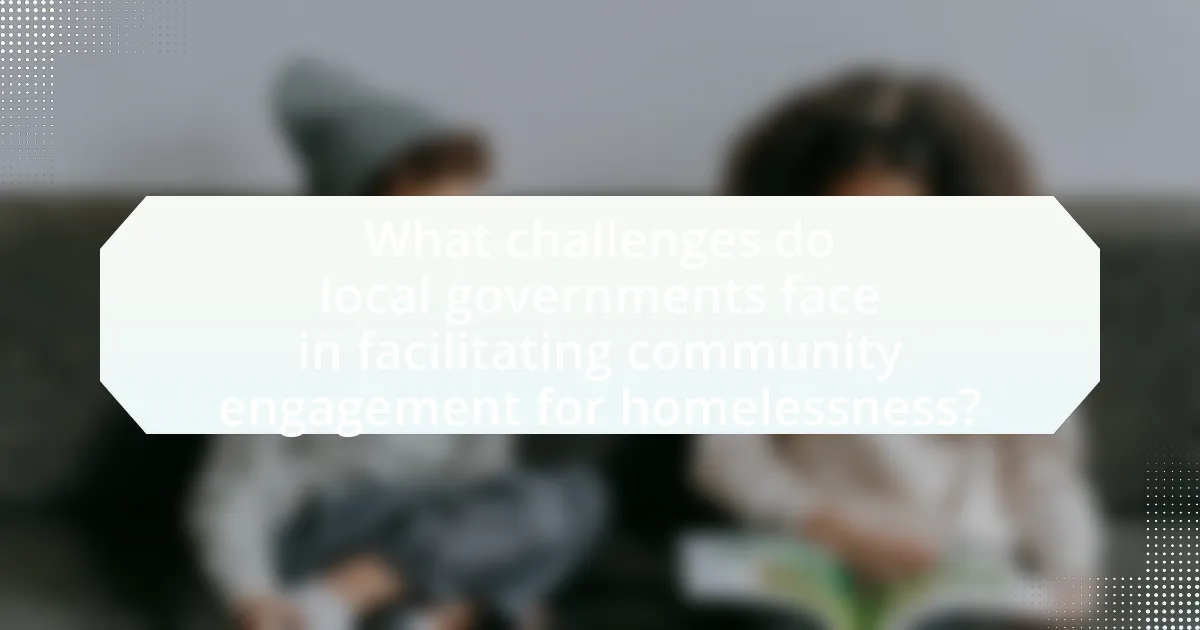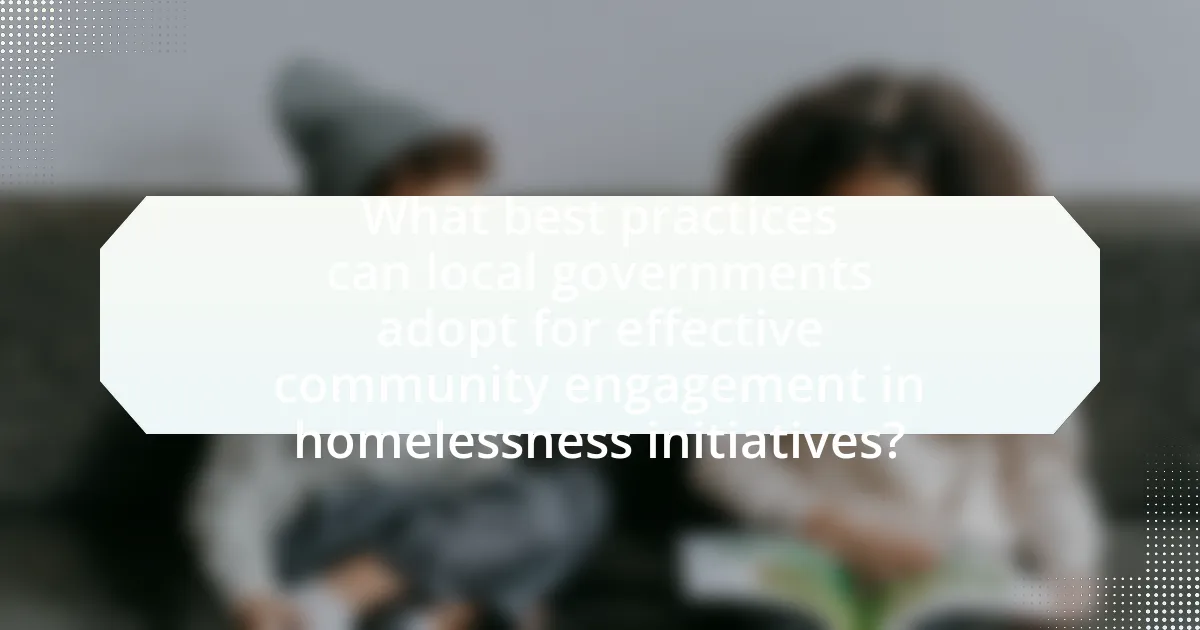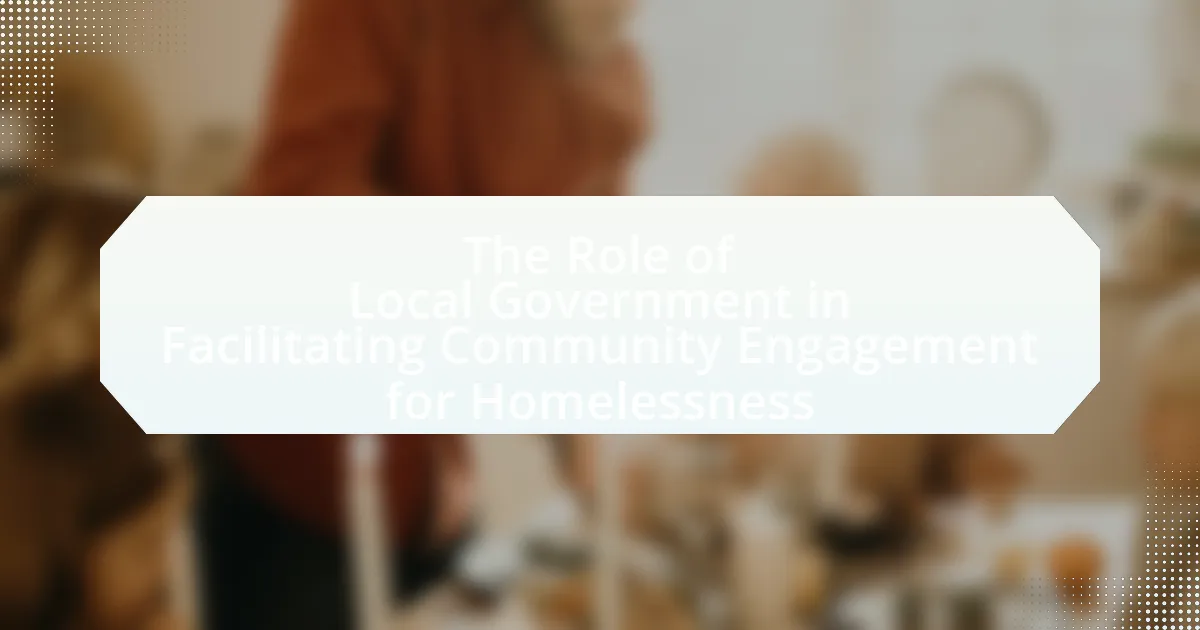The article examines the critical role of local government in facilitating community engagement to address homelessness. It outlines how local governments create policies and programs that promote public participation, including organizing forums and outreach initiatives to gather input from affected individuals. Key responsibilities of local governments include providing emergency shelters, affordable housing, and coordinating with various stakeholders to develop comprehensive strategies. The article also highlights the importance of community engagement in shaping effective policies, the challenges faced by local governments, and successful case studies that demonstrate the impact of collaborative efforts in reducing homelessness.

What is the Role of Local Government in Facilitating Community Engagement for Homelessness?
Local government plays a crucial role in facilitating community engagement for homelessness by creating policies and programs that encourage public participation and collaboration. These governments often organize forums, workshops, and outreach initiatives to gather input from community members, ensuring that the voices of those affected by homelessness are heard. For instance, local governments may implement strategies such as the “Continuum of Care” model, which involves various stakeholders, including service providers and community members, to develop comprehensive solutions for homelessness. This approach has been shown to improve service delivery and resource allocation, as evidenced by the U.S. Department of Housing and Urban Development’s reports indicating that communities employing such collaborative frameworks have seen reductions in homelessness rates.
How do local governments define their role in addressing homelessness?
Local governments define their role in addressing homelessness primarily as facilitators of services and resources aimed at prevention, intervention, and support for affected individuals. They often implement policies that promote affordable housing, provide emergency shelters, and coordinate with local nonprofits and community organizations to deliver comprehensive support services. For instance, according to the U.S. Interagency Council on Homelessness, local governments are responsible for creating and maintaining a continuum of care that includes outreach, housing assistance, and health services, which are essential for effectively reducing homelessness in their communities.
What are the key responsibilities of local governments regarding homelessness?
Local governments are primarily responsible for addressing homelessness through the development and implementation of policies, programs, and services aimed at prevention, intervention, and support. They must provide emergency shelters, affordable housing options, and access to social services, including mental health and substance abuse treatment. Additionally, local governments are tasked with coordinating efforts among various stakeholders, such as non-profit organizations and community groups, to create comprehensive strategies that effectively address the needs of homeless individuals. According to the U.S. Interagency Council on Homelessness, local governments play a crucial role in data collection and analysis to inform policy decisions and allocate resources effectively.
How do local governments collaborate with other organizations to tackle homelessness?
Local governments collaborate with organizations such as non-profits, faith-based groups, and private sector entities to address homelessness through coordinated service delivery and resource sharing. This collaboration often involves creating partnerships that facilitate access to housing, healthcare, and employment services, which are essential for effective homelessness intervention. For instance, the U.S. Interagency Council on Homelessness emphasizes the importance of local governments working with community organizations to implement the Housing First model, which has been shown to reduce homelessness by providing stable housing as a primary strategy. Additionally, data from the National Alliance to End Homelessness indicates that cities employing collaborative approaches have seen significant reductions in homelessness rates, demonstrating the effectiveness of these partnerships.
Why is community engagement important in addressing homelessness?
Community engagement is crucial in addressing homelessness because it fosters collaboration between local governments, service providers, and affected individuals, leading to more effective solutions. Engaged communities can identify specific needs, mobilize resources, and create tailored programs that address the root causes of homelessness. For instance, studies show that cities with strong community involvement in homelessness initiatives report higher success rates in reducing homelessness, as seen in the “Home for Good” initiative in Los Angeles, which involved local stakeholders in decision-making processes. This collaborative approach not only enhances the effectiveness of interventions but also promotes social cohesion and public awareness, ultimately contributing to sustainable solutions for homelessness.
What are the benefits of community engagement for homeless individuals?
Community engagement provides significant benefits for homeless individuals by fostering social connections, enhancing access to resources, and promoting empowerment. Engaging with the community helps homeless individuals build relationships with local residents and organizations, which can lead to increased support networks. These connections often facilitate access to essential services such as housing assistance, healthcare, and job training programs.
Moreover, community engagement empowers homeless individuals by involving them in decision-making processes that affect their lives, thereby increasing their sense of agency and belonging. Research indicates that programs promoting community involvement can lead to improved mental health outcomes and greater overall well-being for homeless populations. For instance, a study published in the Journal of Community Psychology found that community participation significantly enhances the quality of life for marginalized groups, including the homeless.
How does community engagement influence local government policies on homelessness?
Community engagement significantly influences local government policies on homelessness by ensuring that the voices of affected individuals and community members are heard and considered in decision-making processes. When local governments actively involve community stakeholders, they can better identify the specific needs and challenges faced by homeless populations, leading to more effective and targeted policy solutions. For instance, studies have shown that cities with robust community engagement initiatives, such as public forums and collaborative planning sessions, often develop policies that reflect the actual conditions and preferences of the homeless community, resulting in improved service delivery and resource allocation. This participatory approach not only fosters trust between local authorities and residents but also enhances the overall effectiveness of homelessness interventions, as evidenced by successful programs in cities like San Francisco and Seattle, where community input has led to innovative housing solutions and support services.
What strategies do local governments use to facilitate community engagement?
Local governments employ various strategies to facilitate community engagement, including public forums, surveys, and partnerships with local organizations. Public forums allow residents to voice their concerns and suggestions directly to officials, fostering transparency and trust. Surveys gather quantitative data on community needs and preferences, enabling governments to tailor their services effectively. Additionally, partnerships with local organizations enhance outreach efforts, ensuring diverse community voices are represented, particularly in addressing issues like homelessness. These strategies are supported by evidence showing that inclusive engagement leads to more effective policy outcomes and stronger community ties.
What types of outreach programs are implemented by local governments?
Local governments implement various outreach programs to address homelessness, including street outreach, resource fairs, and community engagement initiatives. Street outreach programs involve teams that connect directly with homeless individuals, providing essential services such as food, shelter information, and medical care. Resource fairs are organized to bring together multiple service providers in one location, allowing homeless individuals to access various resources, including housing assistance and job training. Community engagement initiatives often include public forums and workshops aimed at raising awareness and fostering collaboration between local residents, businesses, and service providers to develop comprehensive solutions to homelessness. These programs are designed to create a supportive environment and facilitate access to necessary services for homeless populations.
How do local governments utilize technology to enhance community engagement?
Local governments utilize technology to enhance community engagement by implementing digital platforms that facilitate communication and feedback between officials and residents. For instance, many local governments have adopted mobile apps and websites that allow citizens to report issues, access information, and participate in surveys or polls regarding community needs. According to a 2021 report by the International City/County Management Association, 70% of local governments use social media to engage with residents, providing real-time updates and fostering dialogue. This approach not only increases transparency but also empowers residents to take an active role in local decision-making processes, particularly in addressing issues like homelessness.

What challenges do local governments face in facilitating community engagement for homelessness?
Local governments face significant challenges in facilitating community engagement for homelessness, primarily due to resource limitations, public perception, and coordination among stakeholders. Resource limitations often result in insufficient funding and staffing to effectively implement engagement initiatives, which can hinder outreach efforts. Public perception of homelessness can lead to stigma and resistance from community members, making it difficult for local governments to foster inclusive dialogues. Additionally, the lack of coordination among various stakeholders, including non-profits, service providers, and community organizations, complicates the engagement process, as differing agendas and priorities can create barriers to collaboration. These challenges collectively impede the ability of local governments to effectively engage communities in addressing homelessness.
How do funding limitations impact community engagement efforts?
Funding limitations significantly hinder community engagement efforts by restricting resources necessary for outreach, programming, and support services. When local governments face budget constraints, they often reduce funding for initiatives aimed at involving community members in addressing homelessness, leading to fewer workshops, events, and informational campaigns. For instance, a study by the National League of Cities found that cities with limited budgets reported a 40% decrease in community engagement activities, which directly correlates with lower participation rates and diminished public awareness about homelessness issues. Consequently, inadequate funding results in a lack of effective communication channels between local governments and the community, ultimately impeding collaborative solutions to homelessness.
What are the consequences of insufficient funding on homelessness initiatives?
Insufficient funding for homelessness initiatives leads to a lack of resources for essential services, resulting in increased homelessness rates. When local governments cannot allocate adequate financial support, programs aimed at providing shelter, mental health services, and job training suffer, leading to higher numbers of individuals living on the streets. For instance, a report from the National Alliance to End Homelessness indicates that cities with reduced funding for homelessness services experience a 10-20% increase in homelessness over time. Additionally, insufficient funding hampers outreach efforts, making it difficult to connect vulnerable populations with necessary support, ultimately perpetuating the cycle of homelessness.
How can local governments overcome funding challenges?
Local governments can overcome funding challenges by diversifying their revenue sources. This includes exploring grants from federal and state programs, engaging in public-private partnerships, and implementing local taxes or fees specifically aimed at funding community services. For instance, the National League of Cities reported that cities utilizing a mix of funding strategies, such as leveraging federal funds and collaborating with local businesses, have seen improved financial stability. Additionally, local governments can enhance their budgeting processes by prioritizing essential services and seeking community input to align funding with public needs, thereby increasing transparency and accountability.
What barriers exist in engaging the community effectively?
Barriers that exist in engaging the community effectively include lack of trust, insufficient communication, and limited resources. Lack of trust arises when community members feel that their concerns are not valued or addressed, leading to disengagement. Insufficient communication can result from unclear messaging or failure to reach diverse community segments, which hinders participation. Limited resources, such as funding and staff, restrict local governments’ ability to implement engagement initiatives effectively. According to a study by the National League of Cities, 70% of local officials reported that inadequate resources significantly impede their community engagement efforts.
How do social stigma and misconceptions affect community participation?
Social stigma and misconceptions significantly hinder community participation by fostering negative perceptions that discourage involvement. When individuals perceive homelessness through a stigmatized lens, they may develop biases that lead to exclusionary attitudes, reducing their willingness to engage in community initiatives aimed at supporting homeless populations. Research indicates that stigma can create barriers to empathy and understanding, which are essential for effective community engagement. For instance, a study published in the American Journal of Community Psychology found that communities with high levels of stigma towards homelessness experienced lower rates of volunteerism and participation in supportive programs. This demonstrates that addressing social stigma and misconceptions is crucial for enhancing community involvement and fostering a more inclusive environment for all members.
What strategies can local governments employ to address these barriers?
Local governments can employ strategies such as enhancing collaboration with community organizations, implementing inclusive outreach programs, and providing accessible resources to address barriers in facilitating community engagement for homelessness. By partnering with local nonprofits and advocacy groups, governments can leverage existing networks to reach marginalized populations effectively. Inclusive outreach programs, which may include multilingual materials and culturally sensitive approaches, ensure that diverse community voices are heard. Additionally, providing accessible resources, such as information on available services and support systems, empowers individuals experiencing homelessness to engage with local initiatives. These strategies are supported by studies indicating that collaborative efforts and targeted outreach significantly improve community participation and resource utilization in addressing homelessness.

What best practices can local governments adopt for effective community engagement in homelessness initiatives?
Local governments can adopt several best practices for effective community engagement in homelessness initiatives, including establishing partnerships with local organizations, conducting regular community forums, and utilizing data-driven approaches. Partnerships with local nonprofits and service providers enhance resource sharing and foster trust within the community, as evidenced by successful collaborations in cities like San Francisco, where joint efforts have led to increased outreach and support for homeless individuals. Regular community forums allow residents to voice concerns and contribute ideas, promoting transparency and inclusivity; for instance, the City of Seattle holds quarterly meetings that have significantly improved community feedback on homelessness policies. Additionally, employing data-driven approaches, such as the use of the Homeless Management Information System (HMIS), enables local governments to identify trends and tailor initiatives effectively, as demonstrated by the City of Los Angeles, which has seen a reduction in homelessness through targeted interventions based on collected data.
How can local governments build trust within the community?
Local governments can build trust within the community by fostering transparent communication and actively involving residents in decision-making processes. Engaging citizens through regular town hall meetings and surveys allows local governments to understand community needs and concerns, which enhances accountability. For instance, a study by the International City/County Management Association found that municipalities that prioritize citizen engagement report higher levels of trust and satisfaction among residents. Additionally, implementing feedback mechanisms, such as suggestion boxes or online platforms, further demonstrates a commitment to listening and responding to community input, thereby reinforcing trust.
What role does transparency play in fostering community trust?
Transparency is crucial in fostering community trust as it ensures that information is openly shared and accessible, allowing community members to understand decision-making processes. When local governments provide clear communication about policies, budgets, and initiatives related to homelessness, it builds credibility and accountability. For instance, a study by the International City/County Management Association found that transparency in local governance leads to increased public trust and engagement, particularly in addressing social issues like homelessness. This openness encourages community participation, as residents feel informed and valued in the decision-making process, ultimately strengthening the relationship between local government and the community.
How can local governments ensure inclusive participation from diverse community members?
Local governments can ensure inclusive participation from diverse community members by implementing targeted outreach strategies that engage underrepresented groups. These strategies include conducting surveys in multiple languages, hosting community forums at accessible locations, and collaborating with local organizations that serve marginalized populations. Research indicates that when local governments actively seek input from diverse demographics, such as racial minorities and low-income residents, they can improve policy effectiveness and community trust. For example, a study by the National League of Cities found that inclusive engagement practices lead to higher satisfaction rates among community members and better alignment of services with community needs.
What are some successful case studies of community engagement in homelessness?
Successful case studies of community engagement in homelessness include the “Homeward Bound” program in San Francisco and the “A Way Home” initiative in Canada. The Homeward Bound program effectively connects homeless individuals with family members or friends, resulting in over 1,000 people being housed since its inception in 2012. The program emphasizes collaboration between local government, non-profits, and community organizations to facilitate housing placements. Similarly, the A Way Home initiative focuses on preventing youth homelessness through community partnerships, leading to a 20% reduction in youth homelessness in participating cities. These case studies demonstrate the effectiveness of community engagement in addressing homelessness through collaborative efforts and targeted strategies.
What lessons can be learned from successful local government initiatives?
Successful local government initiatives demonstrate the importance of community involvement in addressing homelessness. Engaging local residents fosters trust and collaboration, leading to more effective solutions tailored to specific community needs. For instance, the City of San Diego’s “Homeless Outreach Program” effectively reduced homelessness by 20% through direct community engagement and partnerships with local organizations. This initiative highlights that involving stakeholders in decision-making processes enhances program effectiveness and sustainability. Additionally, successful initiatives often utilize data-driven approaches to identify and address the root causes of homelessness, ensuring resources are allocated efficiently.
How can these case studies inform future strategies for community engagement?
Case studies can inform future strategies for community engagement by providing evidence-based insights into effective practices and approaches. For instance, a case study highlighting a successful local government initiative in addressing homelessness may reveal the importance of collaborative partnerships with community organizations, which can enhance resource allocation and outreach efforts. Additionally, analyzing the outcomes of various engagement methods, such as town hall meetings or surveys, can guide local governments in selecting the most effective communication channels to reach diverse populations. Research indicates that participatory approaches, where community members actively contribute to decision-making, lead to higher satisfaction and better outcomes in homelessness initiatives, as demonstrated in the “Community Engagement in Homelessness Services” report by the Urban Institute. This evidence underscores the value of leveraging case studies to refine strategies that foster meaningful community involvement in addressing homelessness.
What practical steps can local governments take to enhance community engagement for homelessness?
Local governments can enhance community engagement for homelessness by implementing regular town hall meetings to facilitate open dialogue between officials and residents. These meetings allow community members to voice concerns, share experiences, and propose solutions, fostering a collaborative environment. Additionally, local governments can establish partnerships with non-profit organizations to create outreach programs that educate the public about homelessness and encourage volunteerism. For instance, cities like San Francisco have successfully engaged residents through initiatives that promote direct involvement in local shelters and support services. Furthermore, utilizing social media platforms to disseminate information and gather feedback can significantly increase community participation, as evidenced by studies showing that digital engagement strategies can reach a broader audience.

Leave a Reply